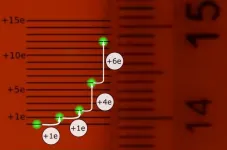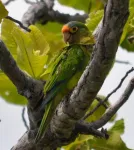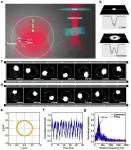New beetle-dwelling roundworm species discovered in Japan
Cryptaphelenchus abietis, a new nematode species isolated from bark beetles that emerged from a dead log in Nagano, Japan, may become a useful lab species because of its culturability
2021-06-17
(Press-News.org) Tsukuba, Japan - Sometimes a dead log isn't just a dead log. This one in Japan turned out to be the habitat of a species previously unknown to science.
In a new study published in the journal Nematology, a University of Tsukuba-led research team has described a new species of nematode found inside bark beetles that emerged from a dead log of a fir tree.
Nematodes, also known as roundworms, are a diverse phylum (category) of unsegmented worm-like animals that live in a wide variety of habitats and have diverse life habits. Many nematodes, including this previously unknown species, are either parasitic or live inside a host organism for the duration of a particular life stage.
The log from the trunk of a fallen Veitch's fir tree (Abies veitchii) was collected from the experimental forest of the Sugadaira Montane Research Center of the University of Tsukuba, Nagano, in June 2018. This log was found to be infected with bark beetles, including the species Cryphalus piceae. These beetles were dissected and their microbial contents cultured to allow the nematodes they contained to propagate. Nematodes were also isolated from the bark of the log. Although several other nematode species were identified, their cultures did not propagate, so only the new species was examined in detail for this study.
Principal investigator of the biodiversity project Professor Yousuke Degawa describes the novel nematode: "Members of the genus Cryptaphelenchus commonly lack a functional rectum and anus, which is a typical characteristic of predator/entemoparasitic species. This suggests that this mycophagous genus has retained this ancestral character. The female of the newly described species can be identified based on its long and slender tail, and the male has a cuticular extension surrounding its tail. We named the species Cryptaphelenchus abietis, for the name of the tree from which it was isolated."
Molecular genetic sequencing clarified the phylogenetic position of this new species in relation to other nematode species. It was clearly a member of the genus Cryptaphelenchus, a group of nematodes that usually feed on fungi when they are not inside their associated insect hosts.
As Senior Researcher Natsumi Kanzaki, the study's first author, explains, "Most similar nematodes have been found to be quite difficult to culture. Because of how easily Cryptaphelenchus abietis can be cultivated in a laboratory setting, this new species may be particularly useful for future studies of the physiological and ecological evolution of nematodes in relation to their genomic characters."
INFORMATION:
The article, "Cryptaphelenchus abietis n. sp. (Tylenchomorpha: Aphelenchoididae) isolated from Cryphalus piceae (Ratzeburg) (Coleoptera: Scolytinae) emerged from Abies veitchii Lindl. (Pinaceae) from Nagano, Japan," was published in Nematology at DOI: http://dx.doi.org/10.1163/15685411-bja10112
[Attachments] See images for this press release:

ELSE PRESS RELEASES FROM THIS DATE:
2021-06-17
Southeast Asian monsoon region falls in the warm and humid tropics modulated by Asian monsoon. It is home to nearly 15% of the world's tropical forests and one of the biodiversity hotspots in the world.
With the unprecedented urbanization and population growing rate, water scarcity issues have already posed a serious challenge for sustainable development in Southeast Asian monsoon region. However, the impact of anthropogenic forcing, such as greenhouse gases and anthropogenic aerosols, on extreme drought events in the region is still unclear.
Scientists from the Institute of Atmospheric Physics (IAP) of the Chinese Academy of Sciences investigated the observed drought changes over Southeast ...
2021-06-17
Researchers at the University of Gothenburg have observed the absorption of a single electron by a levitated droplet with such a magnification that it is visible with the naked eye and can even be measured with a normal millimeter scaled ruler.
Matter in the universe is composed of elementary particles like electrons, protons, and neutrons. They are everywhere, but they are so small that the human eye cannot discern them. In the last century, physicists have proven the existence of these particles through different experiments, but in most cases the observation of the particles have been indirect.
- Electrons are one of these fundamental particles. In 1909, Robert Millikan proved that the charge of the electron is quantized. In other words, there exists a minimum, indivisible ...
2021-06-17
Researchers from Skoltech and Saratov State University have designed a simple and easily reproducible labeling system for individual cells that enables researchers to track single cell behavior and migration for tasks requiring extreme precision. The paper was published in the journal ACS Applied Materials and Interfaces.
Modern biomedical science and developmental biology often require scientists to track and trace individual cells, whether it is to establish the best purified cells from various types of cell lines, in particular to select mesenchymal stem/stromal cells best suited for tissue ...
2021-06-17
The production of chemicals is a cumbersome business. Often, only a small part of what is actually wanted is produced in the factory. The large remainder is unusable - or even worse. Examples? The defoliant "Agent Orange" used by the US army in the Vietnam War was produced in great hurry. It contained dioxin as an impurity. As a result, not only did trees in the combat zone lose their foliage, but US soldiers and Vietnamese civilians also fell ill with cancer years later.
There are also examples from agriculture: In the production of the insecticide lindane, ...
2021-06-17
As a new member of photovoltaic family, antimony trisulfide (Sb2S3) has the satisfactory bandgap of 1.7eV, benefiting the fabrication of the top absorber layer of tandem solar cells. Due to special quasi-one-dimensional structure, it shows advantages of less dangling bonds. Based on these advantages, the vacancy defects upon the surface causing the recombination of the carriers could be reduced sharply, which helps to solve the photovoltaic problems in solar cells.
In the previous studies, the relationships between conformation, chemical composition and ...
2021-06-17
Scientists have developed a new method that improves dispensing of viscoelastic fluids - a vital process for circuit board production, 3D printing and other industrial applications
Viscoelastic fluids are difficult to dispense as liquid bridges that form between the substrate and nozzle must be broken
New research has found that twisting these liquid bridges breaks them in a quicker and cleaner way than the conventional method of stretching them
Researchers used high speed imaging to observe that when twisted, a crack forms at the edge of the liquid bridge and propagates towards the center
The underlying mechanism that breaks the liquid bridge was found to be "edge fracture" and is the first time that ...
2021-06-17
During flock encounters, a single vocal interaction seems to be sufficient for making the decision of whether to recruit an individual or flock. Parrots are known for their splendid ability to imitate, including the contact calls of other individuals during vocal interactions. Such rapid vocal matching is hypothesised to precede and mediate the formation of new flocks. But how are such interactions perceived by others?
Heidi M. Thomsen, first author and PhD student at the Department of Biology, University of Copenhagen explains:
-"By using a novel experimental design, we were able ...
2021-06-17
Seiichi Shirai (1905-1983) was an influential architect whose work has affected the designs of significant architects of the 20th century. Associate Professor Kosuke Hato of the Department of Architecture, Faculty of Engineering, Shinshu University has studied the work of Shirai and examined why the architect worked extensively on calligraphy. Hato's strategy is to clarify the relationship between the architect and his activity of calligraphy through Shirai's Theory of Tradition.
The 1950s in Japan is known as a time when architects actively discussed traditions, and Shirai is a representative example. Hato, in his past article, clarified not only the ...
2021-06-17
Is it possible to drive nanoparticles to orbit below the light diffraction limit using a Gaussian beam? A recent joint research project reported in Nature Communications says yes.
It is well known that light possesses not only energy but also momentum. When light irradiates an object, momentum is transferred to the object, thus generating light pressure on the object. At the microscopic scale, microparticles and nanoparticles (such as biocells and macromolecules) can be manipulated by the light force. Atoms can be cooled by light pressure to achieve atomic clocks, Bose-Einstein condensation, and so on.
In addition to the linear momentum of light being transferable, the angular momentum of light can also be transferred to an object, thus causing object rotation. Since ...
2021-06-17
Tissue-engineering scaffolds built around ultrashort peptides provide a new platform for studying bone regeneration in the lab.
The peptides developed at KAUST self-assemble into a cartilage-like hydrogel that mimics the natural matrix that underpins bone formation in the body. Its physiologically relevant properties enable this cell-friendly biomaterial to support the growth and development of bone marrow precursor cells. It also enables tubular blood vessels to take shape, which is a critical part of bone health and repair.
"Our system is a simple, efficient and robust model that closely resembles the complex architecture of native bone tissue," says Ph.D. student Salwa Alshehri. "Using these peptide-based ...
LAST 30 PRESS RELEASES:
[Press-News.org] New beetle-dwelling roundworm species discovered in Japan
Cryptaphelenchus abietis, a new nematode species isolated from bark beetles that emerged from a dead log in Nagano, Japan, may become a useful lab species because of its culturability





